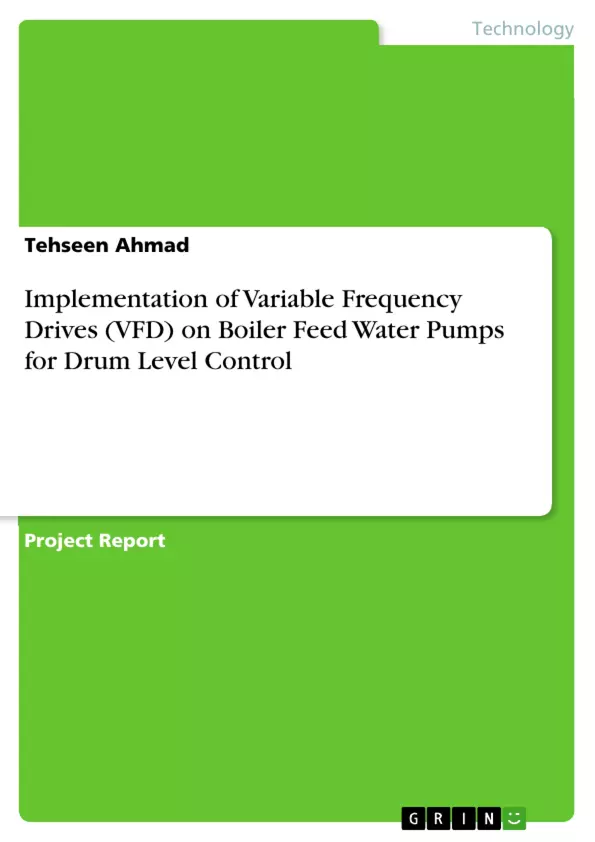The project was to convert the control of three boiler feed water pumps to Variable Voltage Variable Frequency (VVVF) drives having a capacity of 750 m3/H @ 220 Kg/Cm2 pressure and power rating of 6200 KW each.
The main focus of this report is the design and development of the protection system, sequence of operation, bypass system, speed control system, drum level control and graphic interface. It also includes PID controller tuning for VVVF drive smooth control.
Inhaltsverzeichnis (Table of Contents)
- Executive Summary:
- Introduction:.
- Background:
- Responsibilities & Challenges:
- Planning
- Hardware Planning:.
- Software Planning:
- Execution: ....……………….
- Sequential Logic Development
- Mode Selection:
- VVVF Drive ON/OFF Commands:
- BFP minimum flow protection:.
- Sequence System: ......
- Control Logic Development.
- Boiler Drum Volume:
- Boiler Drum Hold up Time:
- Unit Run Back Logic:
- Boiler Drum Water Consumption Rate:
- Drum Level Controller Calculations:
- Boiler Drum Level Adaptive Control:
- Standby Drum Level Control: ........
- DCS Self-sustainability:.
- Simulation & Commissioning:......
- Results & Achievements:
- Implementation of VVVF drives for boiler feed water pumps
- Optimization of plant electrical house load reduction
- Development of a comprehensive control and protection system
- Adaptive control for drum level control
- Successful implementation without OEM support
Zielsetzung und Themenschwerpunkte (Objectives and Key Themes)
This report focuses on the implementation of variable frequency drives (VFDs) for boiler feed water pumps at the Lalpir Power Limited thermal power plant in Pakistan. The main objective was to reduce the plant's electrical house load by converting the control of three boiler feed water pumps to VVVF drives. This involved designing and developing a comprehensive system, including a graphic user interface, protection system, pump sequence control, bypass system, speed control, drum level control via VVVF drives, and PID controller tuning. The report highlights the challenges faced due to the lack of data from the pumps OEM, emphasizing the innovative solutions developed for effective control and protection.
Zusammenfassung der Kapitel (Chapter Summaries)
The report provides a detailed account of the VFD implementation process, outlining the planning, execution, and commissioning phases. It covers the design and development of essential subsystems, including the protection system, sequence system, and control logic. The hardware and software planning sections delve into the specific components and software considerations.
The report then elaborates on the sequential logic development, focusing on various aspects such as mode selection, VVVF drive ON/OFF commands, and minimum flow protection. The control logic development section focuses on key calculations related to boiler drum volume, hold up time, and water consumption rate. The report also discusses the adaptive control strategy employed for drum level control and the implementation of a standby drum level control system. The report concludes with a comprehensive analysis of the simulation and commissioning process, highlighting the successful results and achievements.
Schlüsselwörter (Keywords)
The core focus of this report lies in the implementation of VVVF drives for boiler feed water pumps, encompassing the development of a comprehensive control and protection system. Key themes include plant optimization, adaptive control, PID controller tuning, and system development without OEM support. The report specifically highlights the successful implementation of adaptive control for drum level control, a novel approach that enhances the overall efficiency and stability of the system.
- Citation du texte
- Tehseen Ahmad (Auteur), 2015, Implementation of Variable Frequency Drives (VFD) on Boiler Feed Water Pumps for Drum Level Control, Munich, GRIN Verlag, https://www.grin.com/document/298967



